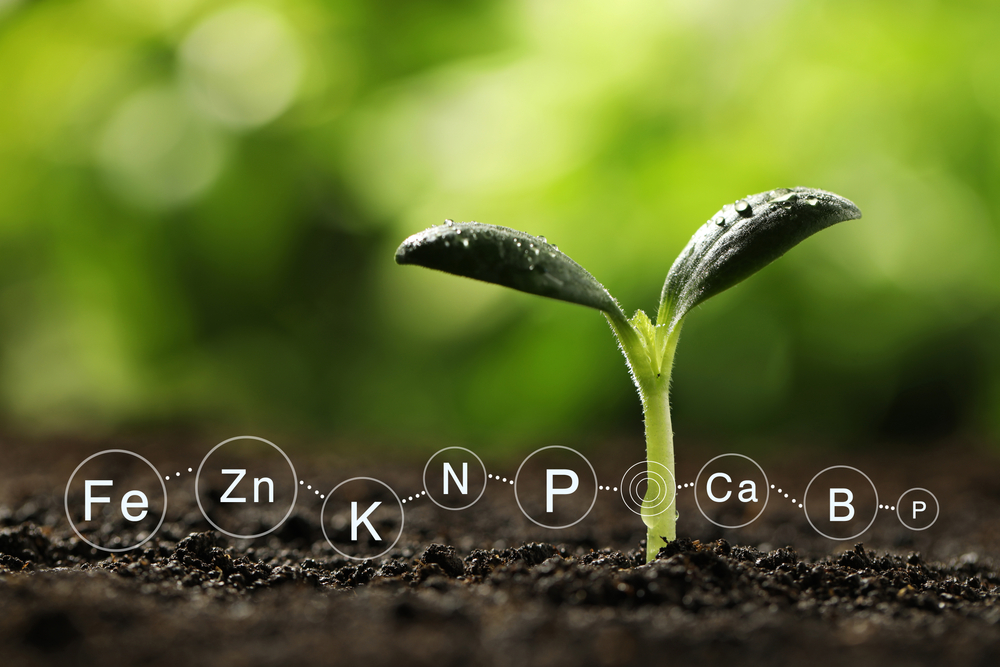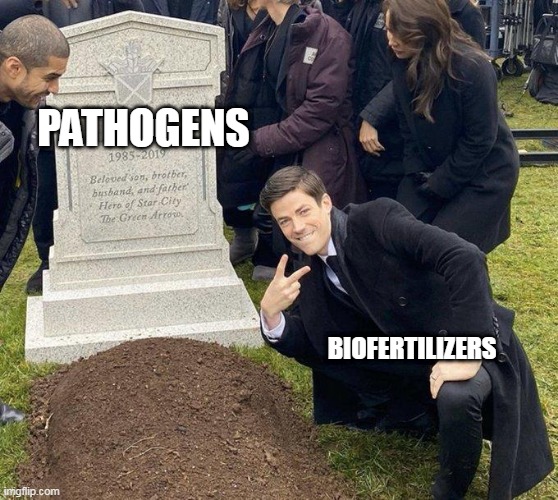Biofertilizers are a living nutrient source for plants. These natural fertilizers have exceptional qualities of eco-friendliness and weed control, coupled with drought resistance and pest management.
Who would you choose to live next to? A friend who shares delicious food or a bad guy who snatches your food? The answer should be clear. Just like you and me, plants love the company of good friends. Biofertilizers are these “good guys” that provide plants with a healthy soil environment. These conditions enable them to get proper nutrition and grow well.
So, let’s dive in to understand what makes biofertilizers a better choice for plants.

Though the plant world can look monotonous, it is home to billions of organisms. Even a handful of soil accommodates billions of microbes, and plants need to compete with these microbes for nutrients. Some help from biofertilizers is great for a plant’s health.
What Are Biofertilizers?
As the name suggests, biofertilizers are living organisms that enhance soil fertility. These include bacteria, such as Rhizobia (for nitrogen), and fungi, like arbuscular mycorrhiza (for phosphorus).

All these microbes have specialized mechanisms that allow them to interact with their hosts. Strains of Rhizobia form mutualistic relations with different legume species. This interaction provides legumes with the required dosage of nitrogen from rhizobia. At the same time, legumes give shelter and food to these strains of Rhizobia.
In the case of mycorrhiza, a specific membrane gene can improve phosphorus exchange. Hence, when in symbiosis with plant roots, they provide enough phosphorus. Don’t you think that plants and biofertilizers are the perfect partners?
Also Read: Why Is Rhizobia-Legume Symbiosis Important?
Types Of Biofertilizers
About 95% of biofertilizers in use by farmers fall into two groups:
- Nitrogen Fixers
- Phosphorus solubilizers
Nitrogen Fixers
Most nitrogen fixers work with bacteria, although a few fungi can also fix nitrogen. Below are some biofertilizers that improve nitrogen availability.
Rhizobia: There are many strains of rhizobium species. Interestingly, each strain interacts with only its group-specific legumes. They are loyal to their hosts and reject symbiosis with other hosts.
Azotobacter: In contrast to the above symbiosis, Azotobacter doesn’t need a host, meaning that they can fix nitrogen as a free-living organism in the soil.
Anabaena: If you enjoy the delicacy of rice delicacy, like me, you can thank this cyanobacterium! This microbe resides in symbiosis with the leaf pockets of the fern Azolla. Thereby, farmers incorporate this fern in rice cropping and yield the benefits of nitrogen.

Phosphorus Solubilizers
Plants have a minute concentration of phosphorus, roughly 0.2% by weight. Though it is found in small amounts, it is vital for biological functions.
You might think that plants can just get this small amount of phosphorus from the soil. The soil does contain lots of phosphorus (especially soil that is fertilized by chemical fertilizers), but this is often in insoluble forms of phosphorus, which plants cannot use without modification. Bacillus sp. (Bacteria) and Pseudomonas (Fungi) convert insoluble forms to plant-available forms, and are therefore called Phosphorus solubilizers.
Other Biofertilizers
Besides the above-mentioned biofertilizers, some bacteria solubilize other micro and macro elements. For example, Bacillus circulans and Bacillus mucilaginous help to solubilize potassium.
Also Read: How Can We Replenish Soil Nitrogen Without Using Synthetic Fertilizers?
How Do Biofertilizers Interact With Plants?
Biofertilizers have different ways of communicating with plants. In the case of symbiotic relationships, you can think of plants as the house owners who provide shelter and food, whereas the microbes pay rent in the form of nutrients!
In contrast, free-living organisms maintain no associations with plants. They fix nitrogen into the soil without host specifications. Hence, they find great use in improving conditions for non-symbiotic plants.
How Do Chemical Fertilizers Compare?
Chemical fertilizers cause extensive damage throughout their production and usage. The production process itself starts with the release of greenhouse gases. And when those chemical fertilizers are applied in the crop fields, the plants fail to hold all the excess fertilizer. These extra elements make their way into our water sources and pollute them.
When water has extra nutrients, it invites harmful guests, such as algae and weeds. These algae and weeds are heavy feeders of oxygen, resulting in their deficiency in the water source. Reduced oxygen concentration in water bodies causes the death of native fish, which disrupts the ecological balance. The damage from chemical fertilizers is not limited to air and water. It also has a dramatic impact on soil health, making land barren after just a few years of usage.

All natural resources have intrinsic links. Therefore, the fertilizers end up in food and water sources, causing health damage in the long term. One can only imagine the damage that chemical fertilizers are causing to our planet at this very moment.
Also Read: How Do Fertilizers Harm The Environment?
Benefits Of Biofertilizers
Biofertilizers, being living organisms, absorb carbon dioxide during respiration. Hence, they represent a natural carbon sink fertilizer. These organisms have enzymes and genes that make them efficient nutrient sources, and they involve no harmful elements. For example, rhizobium has the enzyme nitrogenase, an essential factor in fixing nitrogen. Since the production is completed by existing microbes, it adds no pollutants to the soil.
The microorganisms maintain a close relationship with plant roots, and offer no place for excess nutrients. Hence, biofertilizers eliminate seepage issues, making them a perfect solution for over-application. They also improve soil health and help maintain ecological balance.
Unlike chemical fertilizers, biofertilizers give plants the added benefit of drought tolerance in a safe manner. Exudates of biofertilizers can hamper the growth of certain weeds and pathogens. This resistance cuts down the need to use other chemicals, like herbicides. Thus, the replacement of chemicals with biological fertilizers heals the environment.

Conclusion
Chemical fertilizers gained popularity during the years of the Green Revolution. While it had the initial appearance of a boon in the agricultural world, its gradual harm is far worse than anyone could ever have imagined.
You might wonder why farmers are still using these conventional fertilizers, given that they are essentially a slow poison. Although harmful, they improve plant yield during their early years of usage, so they attract farmers. In the long term, however, soil depletion starts causing huge yield losses, while the excess elements contaminate water sources and crops.
With recent organic trends, the search for sustainable options has picked up speed. Biofertilizers solve the serious issues of fertilizer over-application, soil depletion, and water pollution. They also stabilize the plant’s tolerance to droughts. In addition, biofertilizers can provide solutions to the issues of chemicals ending up in the food chain. Therefore, biofertilizers stand as an exceptional replacement for chemical fertilizers, and should be treated as such by every agricultural producer on the planet!
How well do you understand the article above!

References (click to expand)
- Role of Soil Bacteria - Ohioline - The Ohio State University. The Ohio State University
- Fasusi, O. A., Cruz, C., & Babalola, O. O. (2021, February 17). Agricultural Sustainability: Microbial Biofertilizers in Rhizosphere Management. Agriculture. MDPI AG.
- (1979, April 11). The Rhizobium -legume symbiosis. Proceedings of the Royal Society of London. Series B. Biological Sciences. The Royal Society.
- Anabaena azollae - an overview | ScienceDirect Topics. ScienceDirect
- Kumar, S., Diksha, Sindhu, S. S., & Kumar, R. (2022). Biofertilizers: An ecofriendly technology for nutrient recycling and environmental sustainability. Current Research in Microbial Sciences. Elsevier BV.
- Arbuscular mycorrhizal fungi: tiny friends with big impact. turf.umn.edu
- How a biofriendly fertilizer could offer a greener way to grow .... Harvard University
